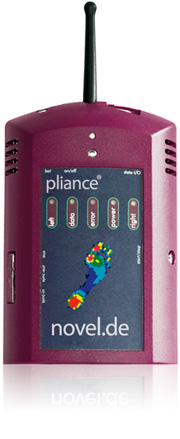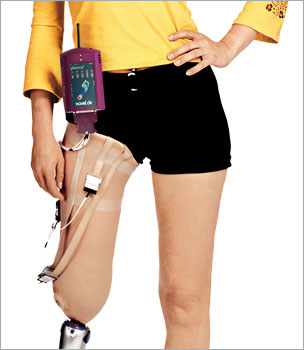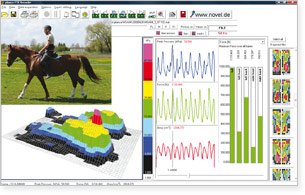Home
Medical

Posturography
The innovative pedar® posturography
recording and analysis system
posturography quantifies postural control in stance in either static or dynamic conditions.
Computerized dynamic posturography (CDP), also called test of balance (TOB), is a non-invasive, specialized, new clinical assessment technique used to quantify the central nervous system´s adaptive mechanisms (sensory, motor and central) involved in the control of posture and balance, both in normal (such as in physical education and sports training) and abnormal conditions (particularly in the diagnosis of balance disorders asdand in physical therapy and aspostural education). Due to the a complex interactions among sensory, motor, and also central processes involved in posture and balance, CDP requires different protocols in order to differentiate among the many defects and impairments which may affect the aspatient's
posture control system.
pedar® posturo software
Regular posturography systems measure the time course of the Centre of Force (CoF). The shift of the CoF in the x and y direction over time is only calculated from the total force measured under both feet and does not describe the exact participation of each foot. By measuring the pressure distribution underneath the feet the pedar posturo system allows not only to measure the force balance between the left and the right foot but also to determine which part of the foot is contributing to the balance.
This is possible because the forces are calculated from many sensors arranged in a sensor matrix. Local forces such as those under the forefoot or toes and the heels can be measured and it can be analyzed how much they contribute to the dynamic balance of the body.The pedar posturo software calculates many parameters such as CoF/CoP, forces in masks, time processes, direction of motion, numerical excentri-city, area of CoF/CoP motion and more.
It is also possible to track the CoP of each individual foot in bipedal stance mode to analyze the motor function individually and compare it with unipedal stance.pedar® posturo hardware.
The pedar®-x posturo system is an accurate and reliable pressure distribution measuring system for monitoring local loads and total forces. The pedar®-x offers the ultimate versatility with its multiple standard features and operating modes.
The pedar®-x can be tethered to a PC via a fiber optic/USB cable. It can also function in a mobile capacity with its built-in BluetoothTM technology or, as yet another alternative, the pedar®-x system’s built-in flash memory storage allowing data to be collected anywhere and later downloaded to the computer.
The pedar®-x can be used not only for posturo-graphy but also for mobile pedography.
The pedar®-x system allows multiple synchronisation options to use with EMG and video systems. The pedar®-x can be started and synchronised by a small wireless remote control.
trublu® calibration device
With the aid of the new trublu® calibration device, all sensors of the pedar® posturo system are individually calibrated using a known air pressure.
This procedure is computer-assisted and can be performed in a short time.
Calibration guarantees accurate and reproducible data. The calibration curves, one for each sensor, can be checked by the user at any time.
This method guarantees the accuracy of the absolute values measured, not only for the distri-bution of dynamic body weight, but also for the local load on each area of the feet.
All sensor mats come calibrated and calibration can be tested at any time.
pedar® posturo sensor mats
- number of sensors 10x22 each
- sensor dimensions (mm) 20x20 each
- weight (gr) 500 each
- pressure range (kPa) 10 - 400
- frame rate (Hz) 40
pedar® posturo system:
Applications of pedar® posturo system
- neurology
- orthopaedics
- osteopathy
- aid in orthotic design
- rehabilitation assessment
- sport biomechanics
- biofeedback
Flyer in PDF
Can the pliance pressure mat accurately locate the COP position in a standing subject? (ppt)

Prothesis | Hardware
New hardware options coming soon!
Mobile options will include internal memory and wireless options. USB connections and faster smapling rates will be available!


Pliance-RLS system
The basis for the novel systems is calibrated, accurate and reliable capacitive sensors. The individual sensor elements are elastic and arranged in a matrix, which conforms easily to 3-dimensional shapes. The sensor matrix is connected to the novel pliance mobile electronic hardware, which accepts a maximum numbre of 256 sensor elements, or to the plaince-ftm analyser, which accepts up to 12,000 sensors. Pressure analysis can be performed with a cabled or mobile(wireless or data logger) system using a Windows PC.
As with all novel pedar and pliance systems, a calibration device can be supplied with the system. The calibration device can be used at any time to verify the quality of the measuring results.
Sensors:
Socket sensors

Horseback | Hardware
New hardware options coming soon!
Mobile options will include internal memory and wireless options. USB connections and faster smapling rates will be available!
The basis for the novel systems is calibrated, accurate and reliable capacitive sensors. The individual sensor elements are elastic and arranged in a matrix, which conforms easily to 3-dimensional shapes.
The sensor matrix is connected to the novel pliance mobile electronic hardware, which accepts a maximum numbre of 256 sensor elements, or to the plaince-ftm analyser, which accepts up to 12,000 sensors. Pressure analysis can be performed with a cabled or mobile(wireless or data logger) system using a Windows PC.
As with all novel pedar and pliance systems, a calibration device can be supplied with the system. The calibration device can be used at any time to verify the quality of the measuring results.

Prosthesis | Software
The pliance socket sensor system was designed for the prosthetist to measure pressure at the residual limb and prosthetic interface. A maximum of 16 sensors can be attached simultaneously to the pliance socket sensor system.
The general pliance data acquisition software operates in a Windows environment and contains many useful methods of data collection and scientific analysis of dynamic pressure. Features include: calibrated pressure values for each individual sensor element; Center of Pressure; 2D, 3D and isobar displays; force, pressure and area-time graphs.
Our robust analysis software can be used for data organization and detailed analysis.
Flyer
PMS sensors / prosthesis

Horseback | Software
pliance®-s test system
The pliance®-s system marks the beginning of a new era in the assessment of the dynamic inter-action between the horse, the saddle and the rider.
How does the rider sit?
How does the saddle fit?
What does the horse feel?
pliance®-s measures the dynamic pressure distribution between the saddle and the horse using a thin elastic sensor mat.
It is possible to assess quantitatively the commands of the rider and the subsequent reaction of the horse. The technique of the rider can be objectively assessed and corrected. Data can be immediately viewed with easy to use software.

Using pliance® recorder software, the dynamic pressure distribution can be directly compared to synchronized video pictures.
Harmful pressure points that arise from poor saddle fit can be recognized and corrected. During dynamic movement, such as trotting and gallopping, substantially higher loads occur on the back and the shoulders of the horse as compared to standing. The pressure distribution under the saddle during dynamic movement of the horse can be measured in order to assess the fit.
The pliance®-s sensor mat contains 2 x 128 sensors which are scanned with a scanning speed of 20,000 sensors per second. Dynamic measurements can be recorded for all paces, from the walk to the gallop.
Gait asymmetry of the horse, possibly associated with physiological back problems or poor saddle fit, can be assessed quantitatively. The pliance®-s system is accurate and reliable. The sensor mat is calibrated in a simple, computer- aided procedure which calculates the calibration curves for each individual sensor. The calibration remains stable with time.
The pliance®-s software operates as a Windows application and displays dynamic pressure distribution on screen as a 2D or 3D color picture. The pictures can be printed in their original size to allow the user to relate the pressures precisely to the horse’s anatomical landmarks or to the saddle.
All data are fully compatible with novel scientific software packages and can also be exported in ASCII format.
With the help of the pliance®-s system and its powerful software one can analyse the quality of the saddle and obtain a better understanding of the interaction between the rider, the saddle and the horse.
Features of pliance®-s system
- can measure English and Western saddles
- adapts perfectly to horseback and saddle shape
- measures in static and dynamic mode
- stores data on a flash memory up to 30 min without computer
- collects accurate, calibrated values
- scans 60 frames per second
- records video synchronized
- includes telemetry
- works with Windows
Technical data of pliance®-s system
- number of sensors 2 x 128
- sensor mat thickness (mm) 2.6
- measurement range (kPa) 1 - 60
- measurement frequency (Hz) 60
- dimensions of pliance box (mm) 150 x 100 x 40
- weight (g) 360
- storage type 32 MB internal flash
- recording time to internal flash (min) 30
- operating system Windows
- power supply NiMH battery, 4.5 hours
- computer interface fiber optic/USB and BluetoothTM
The general pliance data acquisition software operates in a Windows environment and contains many useful methods of data collection and scientific analysis of dynamic pressure.
Features include: calibrated pressure values for each individual sensor element; Center of Pressure; 2D, 3D and isobar displays; force, pressure and area-time graphs.
Pictures can be printed in real size(1:1) to allow the user to find the locations of high pressure and relate them exactly to the horse´s anatomical landmarks or to the saddle.
Our robust analysis software can be used for data organization and detailed analysis
Flyer
Pliance saddle systems






























